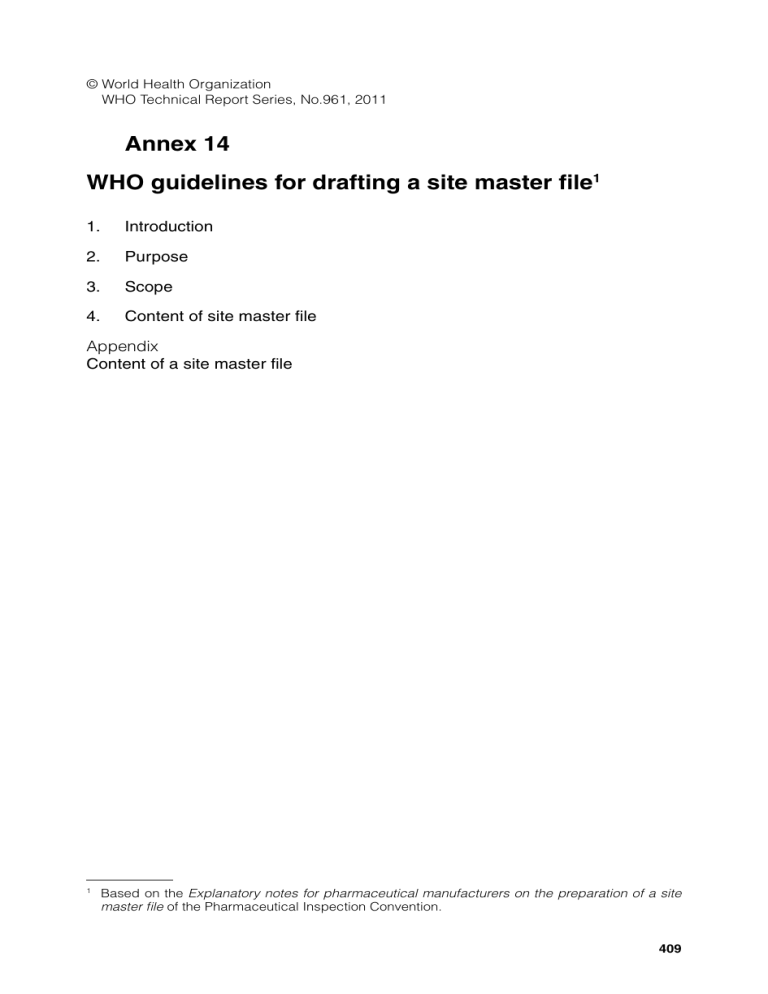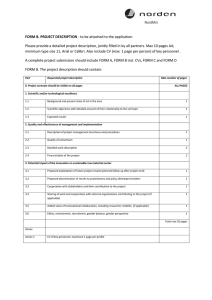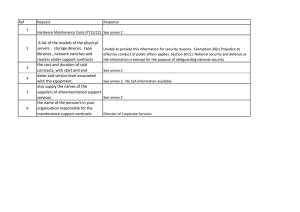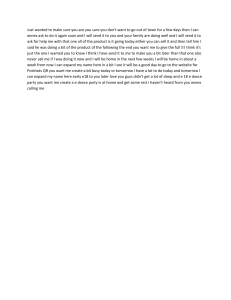
© World Health Organization WHO Technical Report Series, No.961, 2011 Annex 14 WHO guidelines for drafting a site master file136 1. Introduction 2. Purpose 3. Scope 4. Content of site master file Appendix Content of a site master file 1 Based on the Explanatory notes for pharmaceutical manufacturers on the preparation of a site master file of the Pharmaceutical Inspection Convention. 409 1. Introduction 1.1 The site master file (SMF) is prepared by the pharmaceutical manufacturer and should contain specific information about the quality management policies and activities of the site, the production and/or quality control of pharmaceutical manufacturing operations carried out at the named site and any closely integrated operations at adjacent and nearby buildings. If only part of a pharmaceutical operation is carried out on the site, an SMF need only describe those operations, e.g. analysis, packaging, etc. 1.2 When submitted to a regulatory authority, the SMF should provide clear information on the manufacturer’s good manufacturing practices (GMP)-related activities that can be useful in general supervision and in the efficient planning and undertaking of GMP inspections. 1.3 An SMF should contain adequate information but, as far as possible, not exceed 25–30 pages plus appendices. Simple plans, outline drawings or schematic layouts are preferred instead of narratives. The SMF, including appendices, should be readable when printed on A4 paper sheets. 1.4 The SMF should be a part of documentation belonging to the quality management system of the manufacturer and kept updated accordingly. The SMF should have an edition number, the date it becomes effective and the date by which it has to be reviewed. It should be subject to regular review to ensure that it is up to date and representative of current activities. Each annex can have an individual effective date, allowing for independent updating. 2. Purpose The aim of these explanatory notes is to guide the manufacturer of medicinal products in the preparation of an SMF that is useful to the regulatory authority in planning and conducting GMP inspections. 3. Scope These explanatory notes apply to the preparation and content of the SMF. Manufacturers should refer to regional and or national regulatory requirements to establish whether it is mandatory for manufacturers of medicinal products to prepare an SMF. These explanatory notes apply for all kinds of manufacturing operations such as production, packaging and labelling, testing, relabelling and repackaging of all types of medicinal products. The outlines of this guide could also be used in the preparation of an SMF or corresponding document by blood and tissue establishments and manufacturers of active pharmaceutical ingredients (APIs). 4. Content of site master file Refer to the Appendix for the format to be used. 410 Appendix Content of a site master file 1. General information on the manufacturer 1.1 Contact information on the manufacturer — name and official address of the manufacturer; — names and street addresses of the site, buildings and production units located on the site; — contact information of the manufacturer including 24-hour telephone number of the contact personnel in the case of product defects or recalls; and — identification number of the site as e.g. global positioning system (GPS) details, D-U-N-S (Data Universal Numbering System) number (a unique identification number provided by Dun & Bradstreet) of the site or any other geographical location system. 1.2 Authorized pharmaceutical manufacturing activities of the site — copy of the valid manufacturing authorization issued by the relevant competent authority in Annex 1; or when applicable, reference to the EudraGMP database. If the competent authority does not issue manufacturing authorizations, this should be stated; — brief description of manufacture, import, export, distribution and other activities as authorized by the relevant competent authorities including foreign authorities with authorized dosage forms/activities, respectively; where not covered by the manufacturing authorization; — type of products currently manufactured on-site (list in Annex 2) where not covered by Annex 1 or the EudraGMP database; and — list of GMP inspections of the site within the last five years; including dates and name/country of the competent authority having performed the inspection. A copy of the current GMP certificate (Annex 3) or reference to the EudraGMP database should be included, if available. 1.3 Any other manufacturing activities carried out on the site — description of nonpharmaceutical activities on site, if any. 2. Quality management 2.1 The quality management system of the manufacturer — brief description of the quality management systems run by the company and reference to the standards used; 411 — responsibilities related to the maintaining of the quality system including senior management; and — information on activities for which the site is accredited and certified, including dates and contents of accreditations, and names of accrediting bodies. 2.2 Release procedure of finished products — detailed description of qualification requirements (education and work experience) of the authorized person(s)/qualified person(s) responsible for batch certification and releasing procedures; — general description of batch certification and releasing procedure; — role of authorized person/qualified person in quarantine and release of finished products and in assessment of compliance with the marketing authorization; — the arrangements between authorized persons/qualified persons when several authorized persons/qualified persons are involved; and — statement on whether the control strategy employs process analytical technology (PAT) and/or real-time release or parametric release. 2.3 Management of suppliers and contractors — a brief summary of the establishment/knowledge of supply chain and the external audit programme; — a brief description of the qualification system of contractors, manufacturers of APIs and other critical materials suppliers; — measures taken to ensure that products manufactured are compliant with transmitting animal spongiform encephalopathy (TSE) guidance;237 — measures adopted where substandard/spurious/falsely-labelled/falsified/ counterfeit medical products, bulk products (i.e. unpacked tablets), APIs or excipients are suspected or identified; — use of outside scientific, analytical or other technical assistance in relation to manufacture and analysis; — list of contract manufacturers and laboratories including the addresses and contact information and flowcharts of supply chains for outsourced manufacturing and QC activities, e.g. sterilization of primary packaging material for aseptic processes, testing of starting raw materials, etc., should be presented in Annex 4; and — brief overview of the responsibility sharing between the contract giver and acceptor with respect to compliance with the marketing authorization (where not included under 2.2). 1 For further information please see: http://www.who.int/bloodproducts/tse. 412 2.4 Quality risk management — brief description of quality risk management (QRM) methodologies used by the manufacturer; and — scope and focus of QRM including brief description of any activities which are performed at corporate level, and those which are performed locally. Any application of the QRM system to assess continuity of supply should be mentioned. 2.5 Product quality reviews — brief description of methodologies used. 3. Personnel — organization chart showing the arrangements for quality management, production and quality control positions/titles in Annex 5, including senior management and authorized person(s)/qualified person(s); and — number of employees engaged in the quality management, production, quality control, storage and distribution, respectively. 4. Premises and equipment 4.1 Premises — short description of plant: size of the site and list of buildings. If the production for different markets, i.e. for local country or regional economic areas, takes place in different buildings on the site, the buildings should be listed with destined markets identified (if not identified under 1.1); — simple plan or description of manufacturing areas with indication of scale (architectural or engineering drawings are not required); — layouts and flowcharts of the production areas (in Annex 6) showing the room classification and pressure differentials between adjoining areas and indicating the production activities (i.e. compounding, filling, storage, packaging, etc.) in the rooms; — layouts of warehouses and storage areas, with special areas for the storage and handling of highly toxic, hazardous and sensitizing materials indicated, if applicable; and — brief description of specific storage conditions if applicable, but not indicated on the layouts. 4.1.1 Brief description of heating, ventilation and air-conditioning (HVAC) systems — principles for defining the air supply, temperature, humidity, pressure differentials and air-change rates, policy of air recirculation (%). 413 4.1.2 Brief description of water systems — quality references of water produced; and — schematic drawings of the systems in Annex 7. 4.1.3 Brief description of other relevant utilities such as steam, compressed air, nitrogen, etc. 4.2 Equipment 4.2.1 Listing of major production and control laboratory equipment with critical pieces of equipment identified should be provided in Annex 8. 4.2.2 Cleaning and sanitation — brief description of cleaning and sanitation methods of product contact surfaces (i.e. manual cleaning, automatic clean-in-place, etc.). 4.2.3 Good manufacturing practices critical computerized systems — description of GMP critical computerized systems (excluding equipmentspecific programmable logic controllers (PLCs)). 5. Documentation — description of documentation system (i.e. electronic, manual); and — when documents and records are stored or archived off-site (including pharmacovigilance data, when applicable): list of types of documents/ records; name and address of storage site; and an estimate of time required to retrieve documents from the off-site archive. 6. Production 1.1 Type of products References to Annex 1 or 2 can be made. — type of products manufactured including: • list of dosage forms of both human and veterinary products which are manufactured on the site • list of dosage forms of investigational medicinal products (IMP) manufactured for any clinical trials on the site, and when different from the commercial manufacturing, information on production areas and personnel; — toxic or hazardous substances handled (e.g. with high pharmacological activity and/or with sensitizing properties); 414 — product types manufactured in a dedicated facility or on a campaign basis, if applicable; and — PAT applications, if applicable: general statement of the relevant technology; and associated computerized systems. 6.2 Process validation — brief description of general policy for process validation; and — policy for reprocessing or reworking. 6.3 Material management and warehousing — arrangements for the handling of starting materials, packaging materials, bulk and finished products including sampling, quarantine, release and storage; and — arrangements for the handling of rejected materials and products. 7. Quality control — description of the QC activities carried out on the site in terms of physical, chemical and microbiological and biological testing. 8. Distribution, complaints, product defects and recalls 8.1 Distribution (to the part under the responsibility of the manufacturer) — types (wholesale licence holders, manufacturing licence holders, etc.) and locations (countries or regional economic areas) of the companies to which the products are shipped from the site; — description of the system used to verify that each customer/recipient is legally entitled to receive medicinal products from the manufacturer; — brief description of the system to ensure appropriate environmental conditions during transit, e.g. temperature monitoring/control; — arrangements for product distribution and methods by which product traceability is maintained; and — measures taken to prevent manufacturers’ products tentering into the illegal supply chain. 8.2 Complaints, product defects and recalls — brief description of the system for handling complaints, product defects and recalls. 415 9. Self-inspections — short description of the self-inspection system with focus on criteria used for selection of the areas to be covered during planned inspections, practical arrangements and follow-up activities. Annexes to a submission of a site master file Annex 1 Copy of valid manufacturing authorization Annex 2 List of dosage forms manufactured including the International Nonproprietary Names (INN) or common name (as available) of APIs used Annex 3 Copy of valid GMP certificate Annex 4 List of contract manufacturers and laboratories including the addresses and contact information, and flowcharts of the supply chains for these outsourced activities Annex 5 Organizational charts Annex 6 Layouts of production areas including material and personnel flows, general flowcharts of manufacturing processes of each product type (dosage form) Annex 7 Schematic drawings of water systems Annex 8 List of major production and laboratory equipment 416




